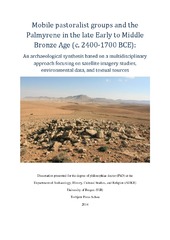| dc.description.abstract | The PhD dissertation “Mobile pastoralist groups and the Palmyrene in the late Early to Middle Bronze Age (c. 2400-1700 BCE): An archaeological synthesis based on a multidisciplinary approach focusing on satellite imagery studies, environmental data, and textual sources” by Torbjørn Preus Schou aims to answer three main questions surrounding the Bronze Age Palmyrene. First, what did the Palmyrene landscape look like in the past and how did climatic developments impact biomes and land-use in the region? Second, what are the features of the thousands of cairns and other archaeological remains documented in the steppe and what can be discerned about their distribution patterns? Third, what is the nature of the suggested link between Near Eastern mobile pastoralist groups and the Palmyrene tumuli? By analysing climatic studies and environmental data, it becomes clear that the Palmyrene looked significantly different in the past, and the present landscape is a result of an ecological disaster occuring in the 20th century CE. Google Earth satellite imagery studies have documented a tremendous extent of three particular archaeological structures in the steppe – tumuli, stone enclosures, and kites – all of which show distinct forms and distribution patterns. Finally, it seems clear that mobile pastoralist groups indeed used the Palmyrene seasonally as spatial focus for a multi-resource procurement strategy, although pasturing of ovicaprines seems to have been the main activity. These pastoralists formed a component of larger kinship groups, which included sedentary people, who by shared tradition and custom could claim territorial rights to both agricultural areas and pasturelands. The latter of these, the vast and open steppes, were marked as ancestral pasture territory by the burial of kinsmen, the erection of monumental cairns, and upheld through post-mortuary rituals carried out annually as part of the mobile season. | en_US |
